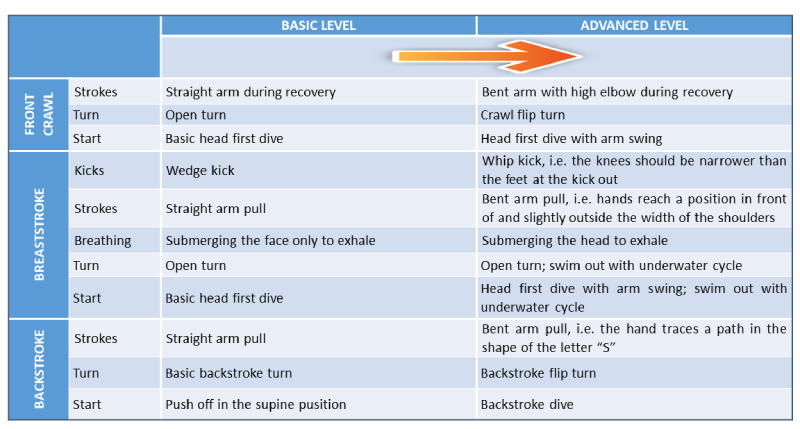|
|
|
Dear user. We designed Learning swimming techniques at the advanced level for swim teachers, coaches, and swim educators to expand their knowledge and help them work with swimmers. The website provides 293 drills (with 379 video clips) for learning four swimming techniques such as front crawl, breaststroke, backstroke and butterfly at the advanced level. The acquisition of swimming techniques is gradual and has developmentally ordered sequences. We use three sequences model in the system of swimming education in Slovenia. These sequences are hierarchical, with the BASIC level less consolidated than the ADVANCED level and even less than the COMPETITIVE level. These techniques are fundamental for recreational and competitive activities. Therefore, they usually form the basis for the advanced programme to learn swimming. In addition to the basic level, the advanced level of swimming techniques includes more complex movements aimed at moving efficiently through the water. The main differences between the basic and advanced levels of swimming in front crawl, breaststroke, and backstroke (butterfly is not usually included in programmes for non-swimmers or novice swimmers) are listed in the table below.  We should emphasize that:
The technical elements of the various swimming techniques are taught in the following order (Amateur Swimming Association, 1977; Thomas, 2005):
The acquisition of the individual elements begins with drills on dry land and continues with drills in water (Figure 1):

Summary of the progression of the swimming techniques acquisition. In the literature you will find several different names for the drills presented on the website. We have tried to be consistent in naming the drills. When naming drills that are performed on land or at/above the edge of the pool or in shallow water or on the wall or from the starting block, the location where the exercise is performed is described first, then the position and/or movement of the learner, and finally the record of the exercise. When naming exercises performed while swimming, only the exercise is described. The website Learning swimming techniques at the advanced level is designed for mobile devices such as phones and tablets. Therefore, the website can be a useful tool for swimming teachers in their work with students. The content of the website is based on the practical experience of many swimming teachers and coaches. We by no means claim that the drills described are exclusive, nor should they be followed completely. However, we believe that the site offers advice and guidance to all those who wish to improve their knowledge of swimming and their effectiveness as swimming teachers.
Authors: Jernej Kapus, Dorica Šajber and Igor Štirn Performers: Lara Pincolič Šajber, Kaja Rožnik, Iza Senčar, Nina Stegu, Blaž Demšar, Luka Rus, and Daniel Soos Camera operators: Jernej Kapus, Dorica Šajber and Igor Štirn Computer graphic and programming: Matej Lekše Video editing: Jernej Kapus, Rok Vertič and Stanko Štuhec Translation from Slovene to English: Lara Lavrič, Petra Bilíčková, Tino Zimmermann, Jere Hannu Knaapia, and Jernej Kapus Reviewer: Venceslav Kapus Publisher: University of Ljubljana, Faculty of Sport Publication Date: February 2023 All material (video clips and text) is the property of the University of Ljubljana, Faculty of Sport. The University of Ljubljana, Faculty of Sport owns the copyright to these video clips. Therefore, they may not be reproduced, edited or published in other media. Contact: jernej.kapus@fsp.uni-lj.si Jernej Kapus, University of Ljubljana, Faculty of Sport, Gortanova 22, 1000 Ljubljana, Slovenia |